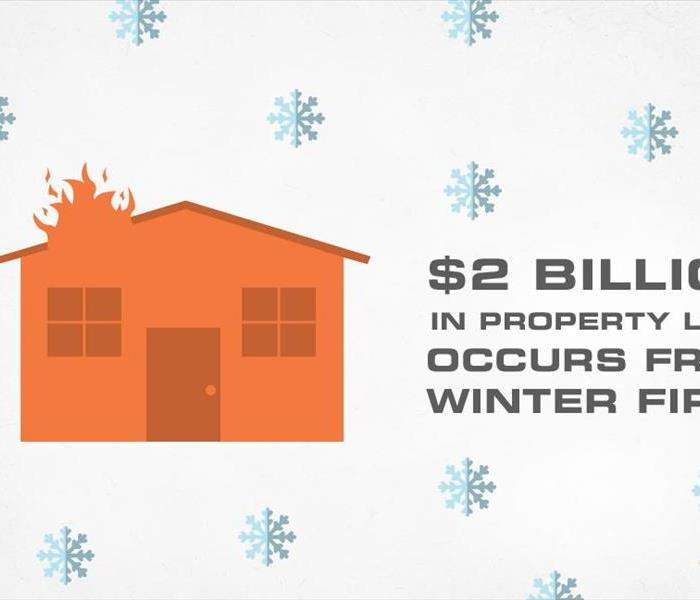Recent Fire Damage Posts
Is the smoke smell you're smelling really there?
8/31/2023 (Permalink)
When we perform fire restoration and cleaning services, especially when heavy amounts of smoke and soot were involved, dealing with the odor is often the most difficult piece of the puzzle.
The primary reasons for this are based in reality. Smoke and soot can travel to all sorts of unexpected places within a home, especially if the home is not dealt with properly in the immediate aftermath of the fire. Soot can often be broken down into microscopic particles that are invisible to the naked eye, which means it can be next to impossible to exactly pinpoint.
But past that, we often find that people suffer "olfactory hallucinations," or "phantosmia," after fires, especially house fires.
These hallucinations cause them to smell fire and smoke even when no one else can, simply because the trauma of the event is so ingrained in their memory.
Can HVAC systems cause fires?
6/21/2022 (Permalink)
Over the past few years, especially during the height of COVID-19, people have been paying quite a bit of attention to their HVAC systems.
These systems, which are crucial for maintaining comfortable temperatures and pleasant indoor environments, are almost always safe and relatively easy to maintain if you know what you’re doing.
That said, we do sometimes see HVAC units causing problems for home and business owners. Specifically, we’ve seen a few fires start within components of the HVAC system and spread throughout the building.
Often, the fire isn’t really the HVAC system’s fault. For instance, a gas leak can start anywhere, but it gets spread by the HVAC system, eventually leading to some kind of combustion.
More commonly, though, we see malfunctions in the HVAC system due to improper maintenance. Specifically, we see motors overheat and catch fire. These problems are almost always preventable and stem from lack of cleaning, insufficient lubrication or poor maintenance in general.
Take our advice – don’t defer necessary maintenance. Take care of your building and it will take care of you.
Can you clean acoustic tile after a fire?
6/21/2022 (Permalink)
Acoustic ceiling tiles are an incredibly common building material. Installed as a drop ceiling on a metal grid, these tiles can easily improve the look of a room while also softening ambient noise pollution.
Unfortunately, in an emergency situation, they’re also incredibly susceptible to damage. Here’s why.
Even in a day-to-day cleaning scenario, acoustic tile is very difficult to clean. These tiles are usually made out of fiberboard and PVC and are extremely porous. If you’ve ever moved one to access the true ceiling in a room, then you know how much dust and debris they can trap.
Even if you try to clean that dust up, you stand a good chance of either being ineffective or damaging the tile. Vacuuming can remove some dust, and some surface cleaning may be possible with a soft brush or even a dry sponge.
But what if the tile has been exposed to water damage, or smoke from a fire?
In most cases, we’ll advise you to throw it away. There may be no real way to restore its integrity and get it back to an acceptable level of clean, and even if there were, it probably isn’t cost-effective. 99% of the time, you’re better off replacing the damaged tile.
The 5 Different Types of Fire Extinguishers
6/21/2022 (Permalink)
Most of us have a pretty unsophisticated grasp of fire extinguishers. We know that they’re red, we know that they’re important, we know that you shouldn’t operate them for no reason (no matter how fun movies make it look), and that’s about it.
Did you know that there are actually five different “classes” of fire extinguishers that specialize in different types of fires? Probably not. Here’s a rundown.
Class A fire extinguishers are effective with ordinary combustibles, like wood, cloth and paper.
Class B fire extinguishers are specialized for use with flammable or combustible liquids. Think greases, tars, oils, alcohol, solvents and even flammable gases.
Class C extinguishers are exclusively for use with energized electrical equipment.
Class D extinguishers are designed for use with combustible metals, including things like sodium and lithium (which is a common material in rechargeable batteries).
Class K extinguishers are more often used in kitchens and are best used with combustible cooking materials (like fats and oils).
Keep in mind that these designations were determined by the NFPA, which is a US-based organization. Other countries have their own classification systems.
Our Esporta Wash System
5/14/2022 (Permalink)
A fire in your home can be a devastating, traumatic event. If the fire affected your possessions, it can be very difficult to figure out what is salvageable and what is a total loss. In fact, most people assume that their soft goods, including everything from clothing to bedding to stuffed animals, will probably need to be disposed of.
At SERVPRO of The Southtowns, that is rarely the case. With our Esporta wash system, we’re able to clean over 98% of the soft contents and textiles that suffer damage during disasters, including items that have suffered heavy smoke and soot damage.
The Esporta system is much different from your typical washing machine. Instead of cleaning via agitation, it uses a process based on hydraulics that separates items into several chambers within the machine itself.
The wash system makes a huge difference in the lives of our customers, as it allows them to get their lives back to normal faster and keep some of their most cherished possessions.
Fire Season is Upon Us
11/8/2021 (Permalink)
We all love the holiday season. There’s nothing better than getting together with family and friends, eating incredible food and taking a few days off for a celebration.
Here at SERVPRO, the months from November through January have a slightly different connotation. That’s because home fires peak in these colder times.
While home fires can certain happen anytime, fall and winter are absolutely the worst times of the year. The reasons for this vary, but the major issue is that there are simply more potential causes of fire when it gets colder out. Furnaces and fireplaces designed to heat your home can malfunction and cause major disasters. Candles, a common holiday decoration, can easily catch draperies on fire if not properly attended.
This holiday season, take time to enjoy yourself. But also remember to stay safe.
This Holiday Season, Burn Candles Responsibly
11/8/2021 (Permalink)
The holiday season comes with many decorations, like Christmas trees and twinkling lights. Many people also like to line their homes with candles, creating a celebratory atmosphere and filling the room with tantalizing scents.
As much as we love candles, they can also pose a risk. In fact, according to the National Fire Protection Association, over 7,500 home fires were started by candles per year from 2014 – 2018. While many of these fires were minor, some turned into serious blazes, claiming 81 lives, injuring 677 people and causing $278 million in property damage.
These types of fires peak during the holiday season, with an average of 21 home fires caused by candles reported each day. The peak day? Christmas.
Thankfully, using candles safely is not rocket science. The main thing you should remember is to keep your candles at least 12 inches from anything that could possibly catch on fire, and to blow them out when you’re done.
Stay safe this holiday season: burn candles responsibly.
How Common is Arson?
6/25/2021 (Permalink)
Arson is a serious problem here in the United States. While most of us will never have to deal with the consequences of arson, those of us that do are burdened not only with a disaster, but the knowledge that it was purposefully created.
How common is arson, though? We’ll dive into the statistics, straight from the FBI’s Uniform Crime Reporting Program.
What is arson?
The FBI defines arson as “any willful or malicious burning or attempting to burn, with or without intent to defraud, a dwelling house, public building, motor vehicle or aircraft, personal property of another, etc.”
In other words, arson means someone set a fire on purpose to destroy property. They might have done this in order to get insurance money, or in the heat of passion, or just to see something burn. As long as it’s “willful or malicious,” it’s arson.
What do we know about arson?
The FBI gathered statistics on arson in 2019. Here’s what they found:
- There were about 33,395 arsons in the United States in 2019 – just over 90 per day on average.
- 42 percent of those arsons were structural, meaning someone attempted to burn down a home, business, storage unit or other building.
- 6 percent of arsons targeted mobile property.
- 35 percent of arsons targeted other sorts of property, e.g. crops, timber and fences, that would not be considered to be mobile.
- The average arson caused $16,371 in damages.
- The most expensive arsons, on average, were in industrial structures or manufacturing plants, where the average dollar loss was $190,336.
- Arson was slightly down year-over-year, decreasing by 4.9 percent.
- There are 10.9 arsons for every 100,000 people living in the United States.
Frankly, these statistics surprised us. We knew arsons happened, but they were much more common than we realized.
If you’re interested in diving deeper into the statistics, you can check them out here: https://ucr.fbi.gov/crime-in-the-u.s/2019/crime-in-the-u.s.-2019/topic-pages/arson
Water and Fire Damage Go Together
6/25/2021 (Permalink)
Do you know the saying that “where there’s smoke, there’s fire?”
It’s accurate, but not comprehensive. The fact of that matter is that when there’s fire, there’s a whole lot of other types of damage, especially water damage.
Water Damage After a Fire
How do you put out a fire?
There are multiple answers to this question, but most commonly, the answer is lots and lots and lots of water.
If your fire prevention system goes off, then it will release enough water in an area localized around the fire to put the fire out. Unlike what you see in movies, not all of your sprinklers will go off – just the ones that need to.
If the fire department responds and has to break out the hoses, it might be a different story. Fire hoses put out huge amounts of water at extremely high pressures designed to battle even the fiercest blazes out there.
They’re excellent for putting out fires. But they also leave a ton of water behind.
The fire department is often very skilled at mitigating this water damage on their own, especially in large multi-level commercial buildings. They may even send in a team just to direct the flow of water to the least damaging areas once the fire has been put out.
This is the point where people often call in SERVPRO. They’re sometimes surprised, when we show up on site, that our first priority is not cleaning up after the fire. Instead, we focus on dealing with the water damage.
That’s because, unlike the extinguished fire, water has the potential to cause additional damage if it is not dealt with immediately. It can soak into your structure, wick into your floors and cause all sorts of problems, including the outbreak of mold.
So the first thing we do at a fire is often extraction. Once we get the water out and start to dry the structure, then we can focus on cleaning up after the fire and purifying the air.
Where there’s smoke, there’s fire. But if all goes well, there’s water, too.
The Four Types of Smoke After Your Fire
6/25/2021 (Permalink)
Not all smoke is created equal. When it comes to smoke damage, there can be a huge amount of difference depending on how the fire originated and what was burned. There are four common types of smoke damage that we see on a daily basis – here’s a rundown.
“Wet” Smoke
The hallmark of wet smoke is its unpleasant smell. If you’ve ever smelled burning rubber or plastic, then you know what we mean.
Wet smoke is produced by a low, smoldering heat. Visually, the plumes are thick and black, and the soot that they produce is greasy.
Wet smoke is very, very difficult to clean on your own due to the greasiness. If you have wet smoke damage, give us a call.
“Protein” Smoke
By “protein,” we basically just mean organic material. If you have a kitchen fire and your roast turkey goes up in smoke, it’s probably producing protein smoke.
Protein smoke can be tricky. Unlike wet smoke, protein smoke is mostly invisible and does not produce obvious stains or smears on your walls.
That’s not to say that you won’t know it’s there. Protein smoke can cause your paint to become discolored, but more than that, it produces a pervasive, pungent stink that can be difficult to get rid of on your own.
Fuel Smoke
This one’s a no-brainer – fuel smoke is produced by burning fuel, like petroleum or oil. We rarely encounter fuel smoke damage outside of a garage or industrial setting, which is lucky – you do not want fuel smoke damage in your home. It smells terrible, produces thick, sticky residues and will ruin most fabrics immediately.
If you have a fuel smoke problem, call the pros.
“Dry” Smoke
You’ve most likely seen dry smoke before. It’s the type of smoke produced by paper or wood, which create a high-heat, powdery smoke when burned.
The powdery nature of dry smoke makes it the simplest to clean, with the least pungent odor. Unfortunately, it also makes it the most insidious. Dry smoke is capable of finding and squeezing into the tiniest, narrowest spaces in your home. It can take an expert to truly find and clean it all.
No matter what kind of smoke damage that you’re dealing with, we can help. Call 716-646-6684 today.
5 Common Causes of Fires (and How to Prevent Them)
4/14/2021 (Permalink)
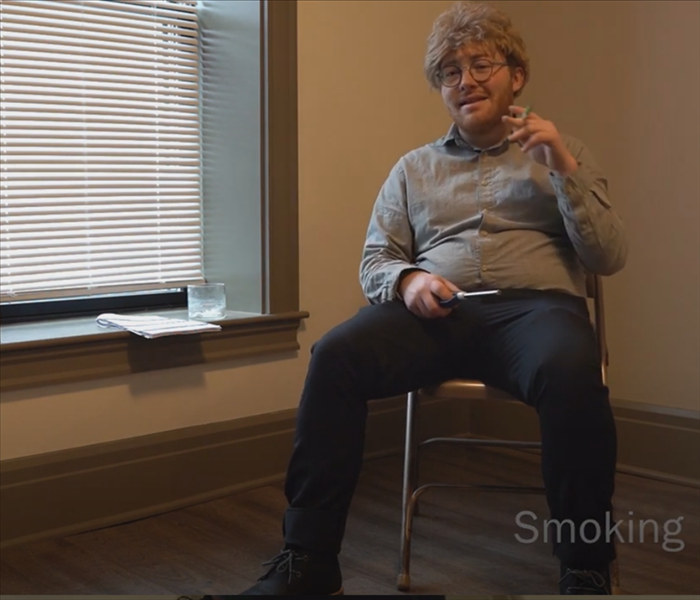 Smoking is one of the leading causes of fires in the US.
Smoking is one of the leading causes of fires in the US.
Hundreds of thousands of fires each year destroy homes, cause harm and disrupt people's lives. Most of them are preventable.
We gathered data on the top 5 causes of preventable fires, as well as how to prevent them, and put them into a fun video to educate property managers in Western New York. We even broke out the wigs for it.
You can check it out here.
Transcript:
I'm here in an apartment and we're going to look at some of the features that are designed for fire protection. It's important to remember that fires are preventable and that the best solution is prevention.
We have fire sprinklers and we have the devices that notify us when those sprinklers are activated.
Let's take a look at some of the common causes.
Cooking Fires
Cooking is the number one cause of preventable home fires and you can see our friend here making huge mistakes left and right. Kind of a dummy.
You should not cook when you're tired, if it's the middle of the night. If you just got home from a late night, be careful.
You should also not cook while you're drinking, especially if you've been drinking more than one or two glasses of wine, because your attention is going to be split to say the least.
In the event of a grease fire, your first instinct is going to be to get some water to put the fire out. Do not do this - you may just cause grease to splatter and you may cause the fire to spread.
Instead of that, cover the fire with a pan. Starved of oxygen, it will go out on its own. You can also use baking soda in some occasions.
That said, if that fire becomes too much to handle or if you start to get worried for your own safety, just get out and call 9-1-1 from outside the apartment, from a neighbor's house, whatever you have to do.
Heating Fires
Of course, in the winter, you need to keep your home warm, especially in Buffalo. But heating elements like fireplaces or space heaters can be major causes of residential and commercial fires.
You should keep anything that can burn at least three feet away from that heating source. You should also turn the heater off when you're leaving the room or if you're going to sleep. I know everybody likes to go to bed toasty, but it's not safe.
Electrical Fires
Electrical fires are also all too common, but they can be avoided with a bit of common sense.
You should only plug in one heat-producing appliance at a time. For major appliances like refrigerators, plug those directly into outlets - don't use extension cords or power strips. Finally, use light bulbs with the right number of watts. Those watts are listed on the sticker on the side in most cases
Smoking Fires
Smoking is less common than it used to be, but it's still a major cause of preventable fires. In fact, according to the National Fire Protection Association, over 17,000 home fires per year were caused by smoking.
Store cigarettes and lighters high up or in locked cabinets so children cannot access them.
Put out your cigarette in a deep sturdy ash tray when you're done. Make sure it's away from anything that could burn.
Candle Fires
Candles can be a major cause of home fires, causing over 7,000 fires per year, especially over the holidays. You should ensure that candles are at least one foot away from anything that could possibly burn. Finally, blow your candles out before you leave the room or go to bed. Everybody likes a bit of ambiance, but it's not safe.
It's important to remember that fires are preventable so long as you know the risks. Still, it's important to be prepared for the worst case scenario, so let's take a look at developing an emergency response plan.
VIDEO: What is Fire Damage Restoration?
4/9/2021 (Permalink)
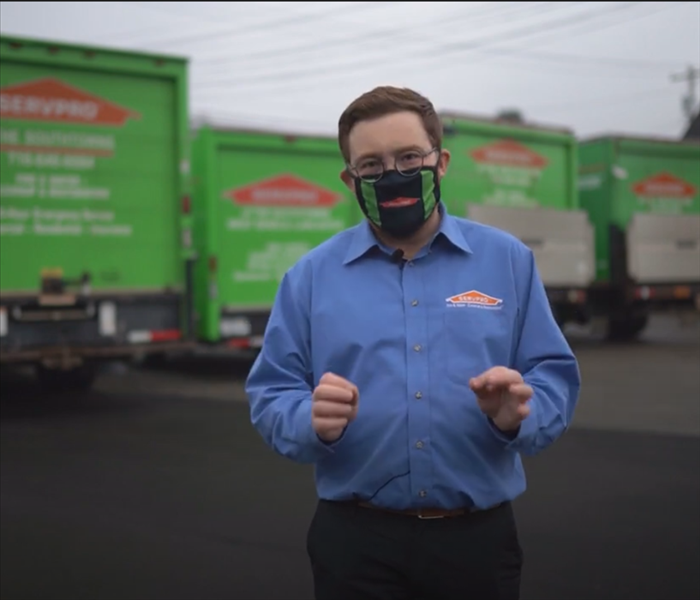 We're not just in the restoration business - we're in the hero business.
We're not just in the restoration business - we're in the hero business.
Most of the time, when people call SERVPRO of The Southtowns after a fire, its their first time dealing with a true catastrophe in their home. They know that they need fire damage restoration - they just aren't quite sure what the means.
We recorded this video to explain the fire damage cleanup, repair and reconstruction process with a little bit of humor.
You can check it out here.
Transcript:
The Fire Damage Restoration Process
Here at SERVPRO, we help people on what's basically the worst day of their lives. Maybe they had a fire, maybe a water main broke, whatever. It's not good. So I like to say we're not really in the restoration business, we're in the hero business. And I want to show you exactly what I mean by that.
We’re Available 24/7/365
Disasters happen when you least expect them. That's why we have dedicated dispatch personnel here to answer your phone calls 24/7/365, just like my friend Blaze here.
On top of that, we also have something called the 1-4-8 Response Guarantee. That means that within 1 hour of your call, even if it's 3 A.M. on Christmas, you're going to get a call back from our on-call staff scheduling a time to get out to you.
If it's an emergency, within 4 hours, they will be on-site to provide emergency mitigation services and stop the damage in its tracks.
Within 8 hours, you're going to have a scope of work that both you and, if necessary, your insurance provider will be able to go over so that you know exactly what you're dealing with. It's just one way that we make any disaster "Like it never even happened."
Emergency Mitigation After a Fire
The first step of any SERVPRO job is mitigation. How can you stop any further damage from occurring?
That's why it really pays off to have an IICRC-certified experienced technician like our friend Stormy here on-site during your loss. They can really assess what can be restored, what needs to be replaced and everything in between. How you doing, Stormy? Great job.
Drying After a Fire Has Been Extinguished
After the mitigation process has taken place, the next step is usually drying everything out and eliminating any more moisture in the structure. This is really important - any lingering moisture can cause structural damage as well as biohazards, including mold.
Our buddy Blaze here is getting ready to load 100 of these air movers onto our vehicles for a large commercial fire - hope you ate your Wheaties this morning, bud!
Structure Cleaning After a Fire
After the drying process starts, then it's time to start cleaning the structure itself. SERVPRO uses over 100 proprietary products along with specialized techniques to make your structure like your fire loss never even happened. Don't forget your Fire Star, Stormy!
Textile and Soft Contents Cleaning After a Fire
Even textiles that have been exposed to some really nasty fires can be cleaned nowadays thanks to our very new, very cool Esporta industrial-grade washing system. This system, independent studies have shown, can clean up to 90% of the soft contents that previously used to have to be disposed of, even if they've been exposed to fire, smoke, soot, water, even bio-contaminants. Not only can it clean them, but it can get them up to food-grade safe. How about that? Think you can throw in my mask there, buddy?
Deodorization – How Do You Eliminate the Smell of Smoke?
One of the most vital things that SERVPRO does to make your loss "Like it never even happened." - we get rid of the smoke smell. Deodorization is one of the most important services that we provide. We have all sorts of specialized techniques and tools, like this o-zone generator, to make it happen. Hey Stormy, let's make the world smell good again, right?
Reconstruction After a Fire
After the restoration process ends, then it's time to rebuild. That's why we here at SERVPRO of The Southtowns have our very own, full-time reconstruction team. Get out there and start building a better tomorrow, Blaze!
Your Restoration Heroes
I hope walking through the warehouse here with you gives you a little bit of a better understanding of what we do here at SERVPRO of The Southtowns every single day. The restoration process - it's got a lot of moving parts, but what you really need to remember is: we're not in the restoration business, we're in the hero business, and we're here for you, to make it "Like it never even happened."
The Most Experienced Fire Restoration Team in Western New York
11/7/2020 (Permalink)
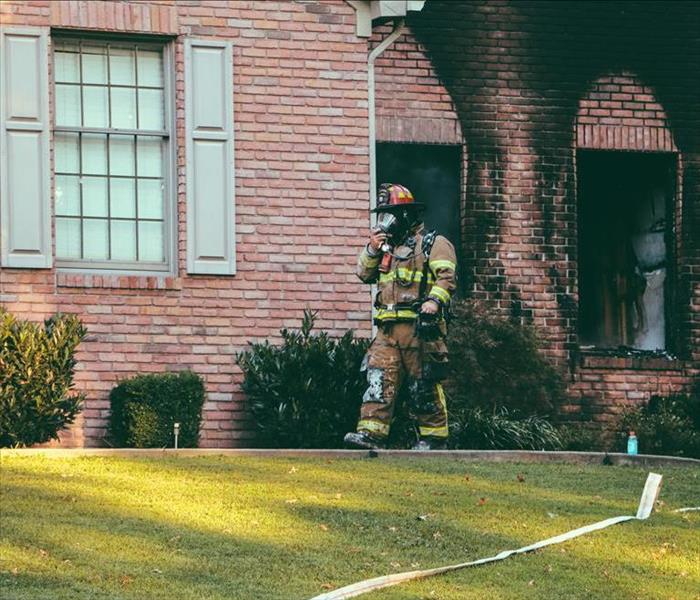 We're here to help our community.
We're here to help our community.
At SERVPRO of The Southtowns, we’re proud to be the most experienced fire restoration team in the Buffalo area. For over 25 years, we’ve been privileged to help our community recover from disasters, no matter how large or how small.
How does the fire damage restoration process work?
First, if you’ve suffered a fire, give us a call so that we can help you to assess the situation. If we think we’re able to help, we’ll send a team to your home or business to examine the damage caused by fire, smoke and soot and either render an estimate or get right to work.
If windows, walls and roofs have been seriously damaged, we’ll start with board-ups and roof tarping to protect you and your family from the elements.
Next, we’ll start the water removal and drying process (if necessary). Often, fires require a large amount of water to put out (from the property owner, sprinkler systems or the fire department). Extracting that water and drying those spaces is priority one.
After that, we’ll begin removing smoke and soot for your ceilings, walls and other surfaces. This removal process is more complicated than you might think, as much of this damage may be invisible (though the odor will definitely be noticeable). We’ll follow that up with a deep cleaning, sanitizing and disinfecting of any items and structures that were affected, including soft contents, which we can clean with our Esporta wash system.
Finally, we complete the restoration process, providing repair and reconstruction services to make your fire “Like it never even happened.”
Need help? Call us 24/7/365 at 716-646-6684 - we’re here to help.
Recovering from a Fire at Your Business in Buffalo
11/7/2020 (Permalink)
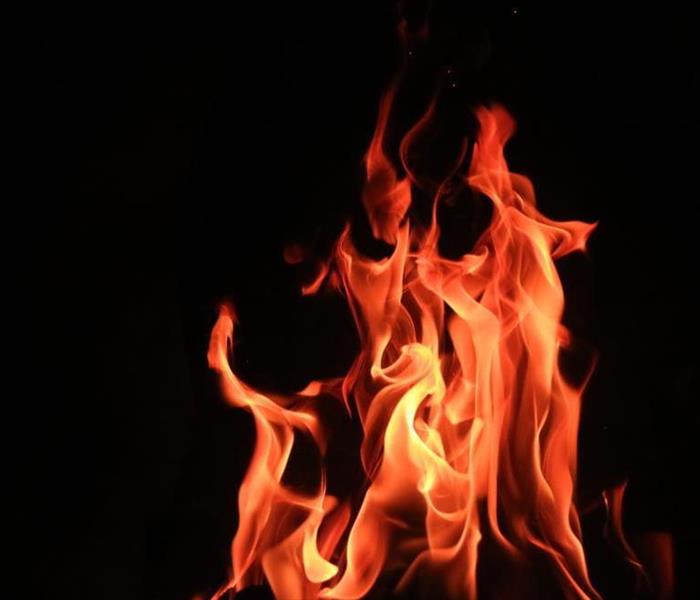 If you suffer a fire, you have to act fast.
If you suffer a fire, you have to act fast.
Suffering a fire can be a terrible setback, especially when it happens at your business. The longer it takes you to recover from the fire, the harder it can be to maintain your income and keep your employees working.
How can you recover from a fire at your Buffalo business? Here are some tips.
Keep Extensive Records
Take pictures of absolutely everything. Keep track of everyone you talk to and what you talk to them about so you can refer back to your conversations. If you have to purchase anything, keep your receipts and log everything in a spreadsheet.
Call Insurance + SERVPRO
Call your insurance agent ASAP and let them know what happened. They’ll help you to figure out if you’re covered and instruct you on how to file a claim if you can. This process takes time and you’ll want to get it kicked off as soon as you can.
You should also call SERVPRO of The Southtowns to discuss your fire, smoke and soot restoration needs. We’ll be happy to work with your insurance carrier to provide the most extensive services possible while minimizing your out-of-pocket costs.
If Your Building Will be Empty, Hire Security
A burned-out building, especially one with damage to windows or access points, is an easy target for thieves, vandals and burglars. The police can only do so much - private security may be necessary if you need overnight or 24/7 oversight.
Board Up Windows and Tarp the Roof
If windows have been damaged or your roof is compromised, SERVPRO of The Southtowns can offer board up and tarping services to protect your building from the elements so that you can avoid further damage.
Call Your Utility Companies
If there’s any potential of damage to your gas, water or electrical lines, get them shut off. Your utility companies should be able to inspect them and certify whether they’re safe to turn on.
Get Your Stuff
Once the fire department gives you the okay to re-enter your business, assess the situation. Do you think you’ll be able to go on with business as usual, or will you be out of your space for a while? If it’s the later, grab everything you need to do your job, as well as valuables, vital records, and anything else that’s irreplaceable.
Kick Off the Restoration Process
SERVPRO of The Southtowns is here to get the restoration process done quickly and thoroughly so you can get back to business as soon as possible. The sooner you call us, the sooner you can get back to work.
Make an Emergency Plan
If you don’t already have an emergency plan put together that people can refer to in case disaster strikes again, or a written plan to get back into your business after a disaster, we can help. SERVPRO of The Southtowns offers professional emergency planning for our customers - call 716-646-6684 for more info.
What Are Soot Webs?
9/23/2020 (Permalink)
 Don't worry - it's just soot.
Don't worry - it's just soot.
Unless you’ve been in a fire- or smoke-damaged home, you probably don’t know what that damage actually looks like. It’s not always like a movie, where things are either untouched or charred beyond recognition. Fire, smoke and soot damage can often take stranger forms.
Take, for example, the soot web. A soot web (actually called a soot tag) resembles a black spider web that’s usually hanging on a wall or a ceiling in a home that has suffered a fire.
When these pop up, homeowners have a wide variety of reactions. Usually, people assume that soot webs are actual spider webs that have been covered in soot. In some cases, homeowners get embarrassed when we point soot webs out – they claim that, before the fire, they kept a very clean home, and they can’t imagine how such a large, eye-catching spider web go there.
If that sounds like you, relax – it’s not your fault. Soot webs are not cobwebs. They form when smoke from rubber or plastic sources ionizes floating soot particles. These particles bind together as they circulate towards cooler areas of the home. Because of this, you may see long strands of soot particles hanging from the corner of the ceiling. It looks an awful lot like a spider web, but you can sleep easy – there’s no such thing as a fire spider.
Cleaning soot webs is not as simple as sweeping away a regular cobweb. If you have a soot web in your home, give SERVPRO of West Seneca/Lancaster a call. We have the training, tools, experience and products necessary to clean soot without causing any further damage in your home.
How Does Fire Damage Restoration Work?
6/8/2020 (Permalink)
 After the fire's out, what's next?
After the fire's out, what's next?
Does a professional restoration company like SERVPRO of The Southtowns really do more than just clean up?
The short answer: yes, there’s much more to restoration than just “cleaning up.” But how does fire damage restoration actually work? What’s the process like? Is it something the average person can do on their own?
We’ll walk you through the basics so you can decide that last question for yourself.
Step 1: Assess Damage
Before any cleanup work actually begins, the fire restoration company has to assess the extent of the damage. This includes assessing damage from the fire as well as damage stemming from smoke, soot and heat. A professional assessor will be able to determine not just how much damage is visible, but how deep the damage has penetrated into the structure of your property.
Step 2: Prevent Further Damage
Damage from a fire does not stop just because the fire has stopped. The next step a restoration professional will take will be to prevent further damage from happening. This step will include fixing any damage to the structure of your building, especially any new holes or leaks that might let moisture in. After all, the last thing you need after a fire is water damage or mold growth.
Step 3: Clean Up
After the damage is assessed and the risk of future damage is mitigated, it’s time to start the cleaning and restoration process. It takes professional tools, techniques and experience to really clean up after a serious fire. Smoke and soot can easily penetrate past the surface level, leading to lingering odor and damage if not cleaned correctly. That goes double for carpet and upholstery, which can hold the smell of smoke forever if not deeply cleaned. In many cases, a restoration professional can advise whether it’s worth cleaning certain pieces of furniture at all, or if it might be less expensive to just replace them.
If there’s extensive water damage (say, from fire department hoses), then a professional restoration company will also be able to help with that by restoring contents, drying the area and preventing the development of mold.
Step 4: Reconstruction
At SERVPRO of The Southtowns, we also offer reconstruction services to help you to truly get back to normal after a fire. No matter how much you’re able to restore after a fire, it’s often less expensive and more efficient to renovate, rebuild and start over. Since we’re familiar with both fire restoration and the reconstruction process, we’re able to advise you on the best way forward after your emergency.
And there you have it: the basic fire damage restoration process. You assess, prevent, clean and rebuild and before you know it, you’re back to normal. Still have questions? Call 716-646-6684 today – we’re here to help!
5 DIY Methods for Eliminating Smoke Odors Before You Call the Pros
6/8/2020 (Permalink)
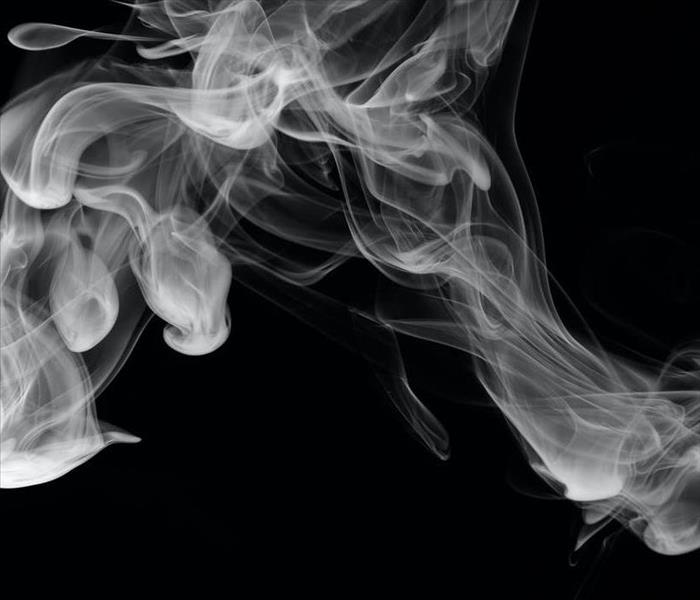 The smell of smoke can last long after the fire is gone.
The smell of smoke can last long after the fire is gone.
After a fire in your home or business, your problems don’t go away just because the flames do. The odor of smoke will likely remain long after you pick up the pieces, repair the damage and replace your belongings. What’s worse, you might find that no matter how much you clean, you can’t get the smell of smoke to go away.
As restoration professionals, we have the resources and experience to get rid of smoke odors for good. That said, we understand that some people don’t want to call in the pros until they’ve tried everything they can to get rid of their smoke smell for good.
So if you’re a DIYer, we’re still here to help! Here are some home remedies for smoke odors that some people have had success with in the past.
Vinegar
On top of having a potent smell of its own, white vinegar naturally cuts through odors of all types, including light smoke odors. Wipe down whatever smells with white vinegar and leave a few bowls of vinegar around the room as well for a few days, then see what happens. If you really hate the smell of vinegar, add a little bit of lavender oil to the bowls – it won’t totally eliminate the smell of vinegar, but it will help.
Baking Soda
If you’ve ever popped a box of baking soda into your refrigerator, then you know that it’s a go-to odor absorber for a reason. If vinegar didn’t work, try sprinkling baking soda on your smelly items and surfaces, as well as leaving bowls of baking soda out to trap any free-floating odors.
Cyclodextrin
What in the world is cyclodextrin? One of the core compounds in odor-fighting products like Febreeze. Cyclodextrin molecules are shaped like donuts, and they “trap” odor molecules in their centers. Febreeze alone probably won’t eliminate your smoke odor, but it might help.
Activated Charcoal
Some people swear by activated charcoal for all sorts of purposes, especially for its detoxifying properties. Again, it probably won’t get rid of smoke odors all on its own, but putting a few bowls of powdered activated charcoal around the room won’t hurt.
Air Circulation
If all else fails, and the temperature is high enough, open every window and door that you can and hope that circulating fresh air will be enough to minimize the smell of smoke.
If you’ve tried all of the above and still haven’t been able to dissipate your smoke odors, you may need a professional. This is especially true if you’re dealing with things like carpets, drapes and upholstery, which can hold the smell of smoke for a very long time. If you’re ready to kick off the fire restoration process, call SERVPRO of The Southtowns at 716-646-6684 today.
What to Do After Your House Fire
6/8/2020 (Permalink)
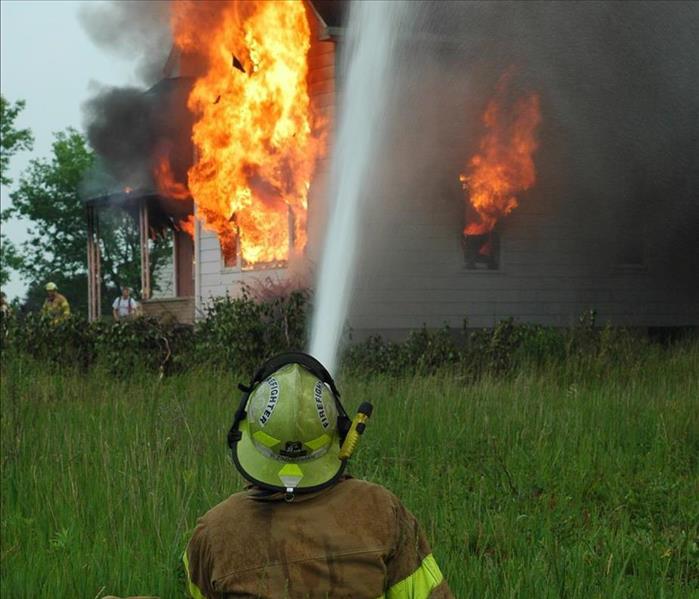 After a house fire, what happens next?
After a house fire, what happens next?
After a house fire, especially a serious one, you’re likely to be in a state of panic, and it can be difficult to know what to do next. Once the fire’s out and everyone’s safe, consider doing the following:
Find somewhere to stay.
If the fire was severe, there’s a good chance you might not be able to stay in your house for a while. Reach out to family and friends and see if they’re able to take you in while you figure things out. If they can’t, connect with a trusted local disaster relief agency in your area – they should be able to help you find housing until you can get back in your home.
Work with insurance.
Hopefully, you’re well-insured with an agent that you trust. You’ll want to get started on a claim ASAP. Ideally, this claim will do more than cover the damage in your home – it will also provide you with money to cover living expenses as you get back on your feet. You may need a copy of the fire report from your local fire department to get this process moving.
Secure your property.
Especially if you won’t be home for a while, you need to make sure that your home is protected from both intruders and the elements. Make sure all points of access are secured and that there aren’t any leaks caused by the fire that could lead to water damage if it rains.
Keep your family healthy – including your pets.
If you have any reason to believe that you or your family was exposed to smoke or fire, consider making a doctor’s appointment to get checked out. The same goes for your pets – they can easily fall victim to smoke inhalation or have burns that aren’t visible under the fur.
Pay attention to mental health as well. Fires are a trying time for everyone – keep up with healthy habits and take care of yourselves.
Make a financial plan.
Sit down and figure out that your finances will look like for the next few months. House fires come with all sorts of unexpected expenses, so it’s important to plan as much as you can so you know how much you can afford to pay. After all, even if your house is gutted by a fire, you still have to keep up with your mortgage.
Inventory your possessions.
Your insurance should hopefully cover any items that were destroyed in your house fire. Make an inventory of what you own, including (where possible) the date of purchase, the cost and a short description of each item. In many cases, insurance will offer the cash value of what you lost so that you can replace it.
Work with the pros to get home.
Work with your insurance, restoration and reconstruction teams to figure out when you can safely move back into your home. The sooner you can get back in your house, the sooner things can get back to some level of normal.
Still not sure what to do after your house fire? Call SERVPRO of The Southtowns at 716-646-6684 – we’re here to help!
Number One Fire Prevention Tip This Fall Season
11/27/2019 (Permalink)
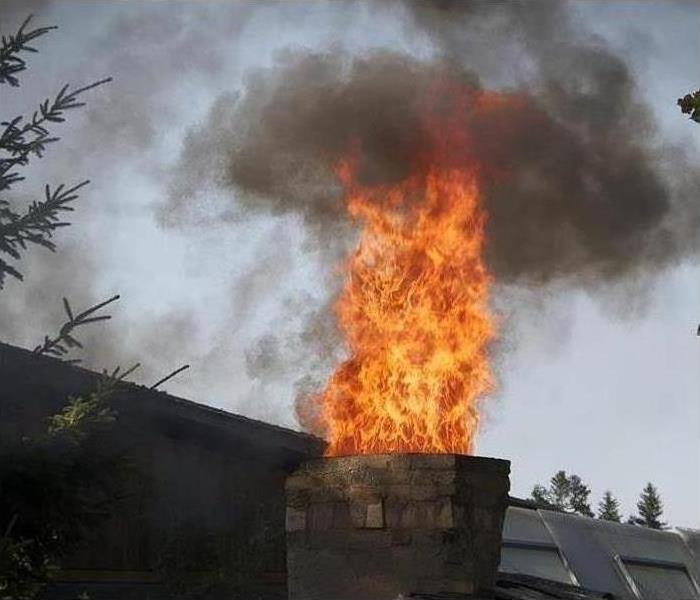 Don't let this be you this fall season. Practice this fire prevention tip and stay cozy, warm and safe this year.
Don't let this be you this fall season. Practice this fire prevention tip and stay cozy, warm and safe this year.
Ah, it’s that time of year again. A chill is in the air, Thanksgiving is right around the corner, and we’ve even seen some snow already! This is the perfect weather to put another log on the fire and cozy up with your favorite blanket while catching up on your favorite TV show. But, before you start that fire there are a few precautionary measures you should take. They could end up saving you thousands of dollars in damages, and suffering a loss right before the Holiday season.
The first thing you should do before EVERY fall/winter season is have your chimney professionally cleaned and swept. In fact, this tip is so important it is also the number one tip of local Hamburg, NY and surrounding areas Fire Departments. We recently spoke to Lt. Bryon from the East Aurora Fire Department and this was the first thing he mentioned. He mentioned that they have already responded to fires this season that were caused from a chimney fire.
Another tip to keep in mind is to make sure the ashes are completely cool before disposing of them in the garbage can. We have seen too many fires that are caused from people disposing of ashes before they are completely cooled. So be mindful of these fire safety tips this Holiday season and you will be warm and safe.
Stay Warm AND Safe This Winter Season
11/27/2019 (Permalink)
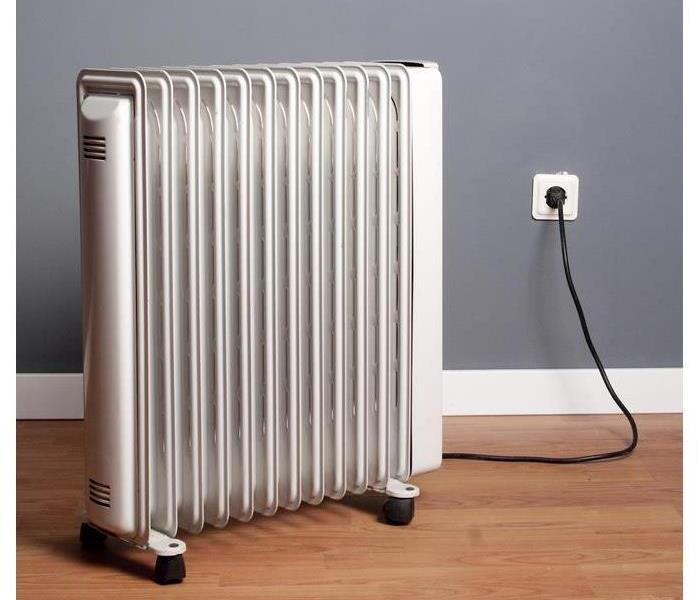 While it's tempting to turn them on to keep the thermostat down, make sure you practice proper safety precautions to stay safe this winter.
While it's tempting to turn them on to keep the thermostat down, make sure you practice proper safety precautions to stay safe this winter.
It seems that everyone these days is trying to save a couple of extra dollars where they can. And, when the weather turns and nights get cooler you may be tempted to turn on that space heater instead of turning up the thermostat. While space heaters are great for warming up small spaces, they also can be a major fire hazard in your home or office.
So, in order to keep yourself safe this winter season remember these safety tips when it comes to using a space heater:
- Keep space heaters at least 3 feet from any surrounding objects.
- Turn space heaters off before leaving the room.
- Avoid using extension cords.
- Place the heater on a level, hard surface.
- Keep space heaters away from flammable items such as papers, blankets, and curtains.
By educating yourself about the safety hazards that come with space heaters, you will have peace of mind knowing your home will be warm, cozy, and safe. If you practice these space heater safety tips this winter season you will stay warm and safe! And of course, should you experience a fire disaster please call SERVPRO of The Southtowns at (716) 646-6684 for all your fire and/or water restoration needs.
Staying Safe and Preventing Fires This Fall Season
9/26/2019 (Permalink)
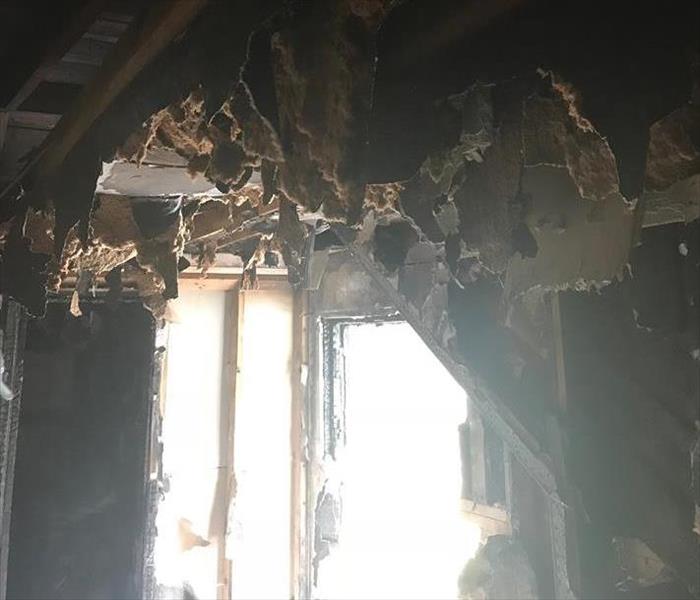 Stay safe this fall and practice these fire prevention tips to prevent fire damage in your WNY home.
Stay safe this fall and practice these fire prevention tips to prevent fire damage in your WNY home.
This summer and early fall seasons, we have noticed an increased amount of fires happening in our WNY area. Fires, no matter how big or small, can be devastating to an individual or family. In order to keep you and your family safe, we would like to share a few fire safety tips that will hopefully help prevent a fire in your home:
- Be sure there are properly working smoke detectors on every floor in your home, and in every bedroom as well. Smoke detectors save lives, especially since 50% of fires happen at night when everyone is sleeping.
- Never leave food that is cooking unattended.
- Avoid using portable and fixed space heaters. If using a space heater is necessary, be sure that there are no flammable objects within 10 feet of it. And, that it is plugged into a safe electrical outlet (not in a surge protector).
- Avoid smoking in the house.
- Check your smoke detectors twice a year (every six months).
Practice these fire safety tips and keep you and your family safe from a house fire. Should disaster strike, and you suffer a house fire this year, please do not wait and call the experts at SERVPRO of The Southtowns immediately at (716) 646-6684 to make your fire damage, “Like it never even happened”.
https://www.safety.com/fire-safety/
Just Suffered a Fire? Read This!
6/12/2019 (Permalink)
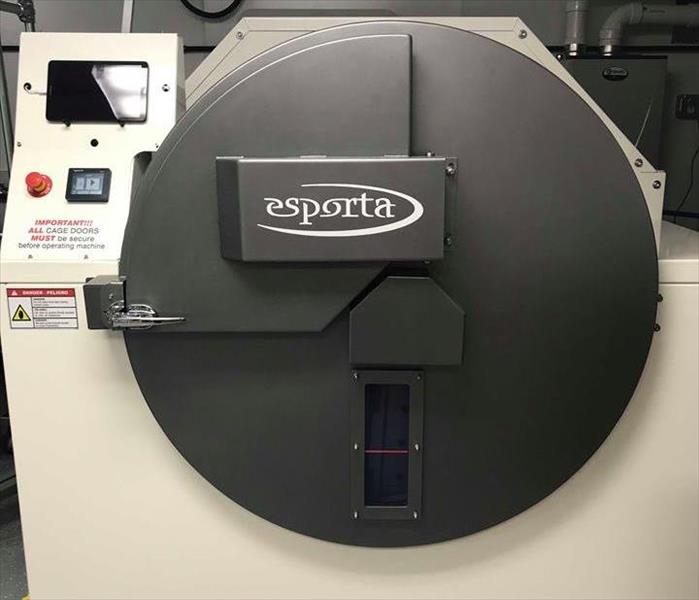 We can now offer Textile Restoration to our list of services!
We can now offer Textile Restoration to our list of services!
The aftermath of a fire can be one of the most devastating times of a person’s life. It is not uncommon for someone to want to feel a sense of normalcy immediately after a fire. You already know that SERVPRO of The Southtowns can take care of the cleanup and restoration of your fire damaged home, but we can now help you with the restoration of your soft goods and textiles too.
What do we mean by textiles? We mean we can restore most, if not all, of your
- Sports equipment
- Soft contents (such as stuffed animals)
- Laundry
- Shoes and handbags
- Curtains
- And so much more
In fact, we are now able to restore 90% of the soft content items in your home and nearly twice as much soft contents than a restoration drycleaner! We can restore items affected by heavy soot, Category 2 & 3 water, mold and bio contamination. And, we can do it in as soon as 48 hours. That means you can get back to normal life even faster! This also means having just one point of contact for all your restoration needs, which helps to make life a little easier during your time of need. Just another way we are, “Here to help” and make it, “Like it never even happened."
If you experience fire damage, please give our office a call at (716) 646-6684 and let the professional experts at SERVPRO of The Southtowns get life back to normal.
Document Restoration Services Right Here in Buffalo, NY
4/11/2019 (Permalink)
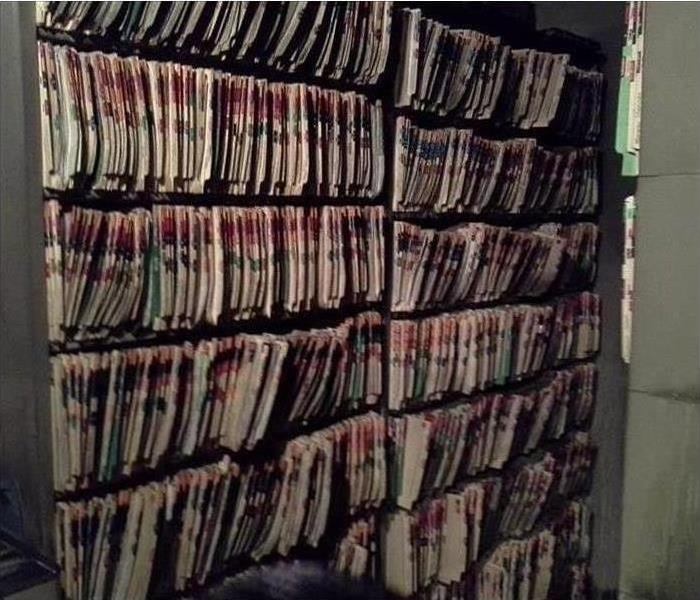 Yes it's true, even documents can be restored after a fire/water loss.
Yes it's true, even documents can be restored after a fire/water loss.
Picking up the pieces after a fire/water loss can be overwhelming at best. Realizing that your documents have been damaged from the loss is even worse. But good news, SERVPRO of The Southtowns can restore your fire/water damaged documents. We understand that several documents, whether they are for residential or commercial use, are important to you and cannot be replaced. They may even contain sensitive information that should not, or cannot be shared. This is why our Technicians are HIPAA compliant and are trained how to deal with sensitive information.
SERVPRO of The Southtowns can take fire/water damaged documents and pull the moisture and odor out using freeze-drying technology. It is important to start this process as soon as possible, so if you have documents that are affected by fire and/or water we recommend putting them in the freezer immediately and then calling our office at (716) 646-6684. This service has helped several doctor’s offices and schools that are required to keep a paper copy of documents. So if you have documents that suffered water and/or fire damage let the experts at SERVPRO of The Southtowns make it, “Like it never even happened."
Restoring Vs. Replacing: Fire Damage Edition
3/18/2019 (Permalink)
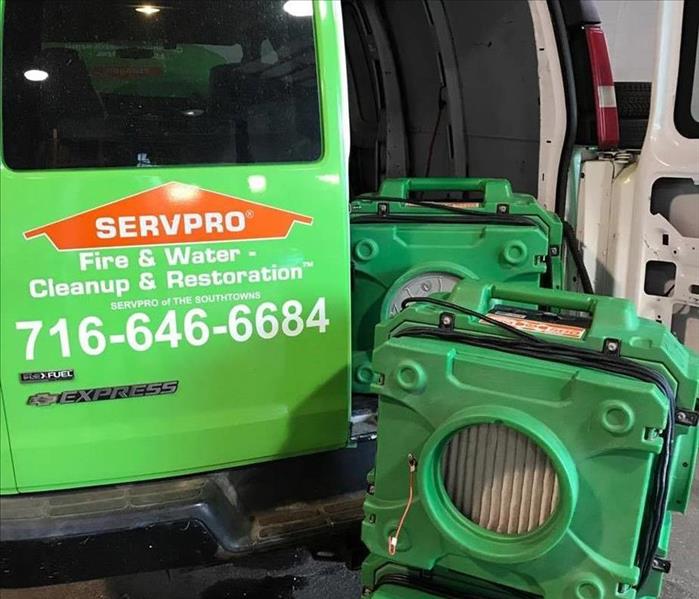 In most cases, it is actually more affordable to restore your belongings after a fire and/or water loss than to replace them.
In most cases, it is actually more affordable to restore your belongings after a fire and/or water loss than to replace them.
After experiencing a fire and/or water loss it is common for people to think that replacing all of their contents would be less expensive than restoring them. As a professional in the Restoration Industry we are here to tell you that is false! The technicians at SERVPRO of The Southtowns are trained to see beyond this common misconception, and restore your contents/valuable to a preloss condition.
The mitigation process of cleaning yields excellent results at a cost-effective price. Mitigation stops further damage and reduces the loss, while restoration puts the damaged items back to their preloss condition. For ultimate results, mitigation needs to begin within twenty-four hours of a loss. Any delay will complicate or, may devalue the mitigation effort. In order to guarantee the removal of smoke odor, all of the contaminated areas need to be cleaned, deodorized and possibly sealed (where applicable). Also, all odor molecules, whether airborne or absorbed, need to be neutralized.
So if you experience a fire and/or water loss this spring, give the experts at SERVPRO of The Southtowns a call (716) 646-6684 to begin the restoration and mitigation process immediately! We are always, “Here to Help”.
Think Twice Before You Plug That Space Heater In
12/3/2018 (Permalink)
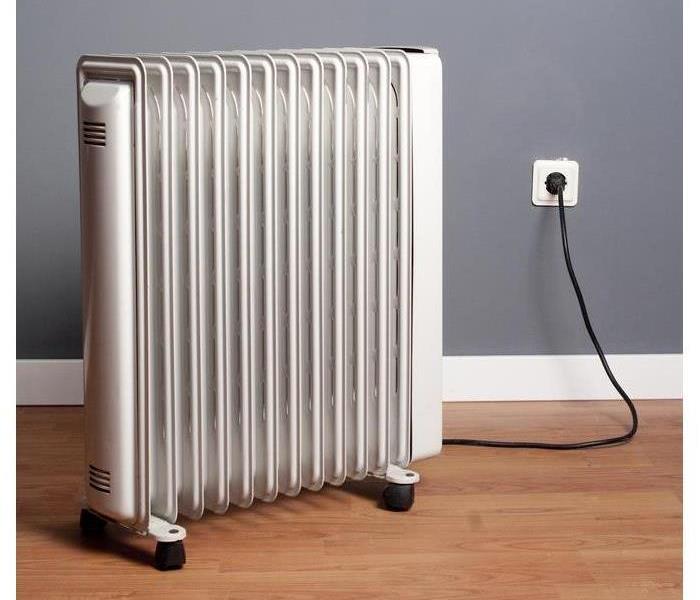 Use extra caution this winter season when operating a space heater. Be sure to follow safety regulations to prevent a fire from happening.
Use extra caution this winter season when operating a space heater. Be sure to follow safety regulations to prevent a fire from happening.
It is that time of year when there is a chill in the air and a little extra warmth is needed. However, if not used properly space heaters can be very dangerous. Here are some great space heater safety tips to prevent a fire in your home this winter season.
Electric space heaters are generally more expensive to operate than combustion space heaters, but they are the only unvented space heaters that are safe to operate inside your home. Although electric space heaters avoid indoor air quality concerns, they still pose burn and fire hazards and should be used with caution.
1. Place heater on a hard, level surface
2. Turn heater off when you leave
3. Keep heater 3 ft. from the nearest object
4. Avoid using extension cords
5. Look for heaters with tip over and over heat protection
6. Keep heaters away from water and flammable items such as papers, blankets, and curtains.
Educating yourself about the safety hazards that come with the improper use of portable heaters will help you achieve better peace of mind as you keep your home warm, comfortable, and fire hazard-free this winter.
Chimney Fires Cause More Damage Then You Think
12/3/2018 (Permalink)
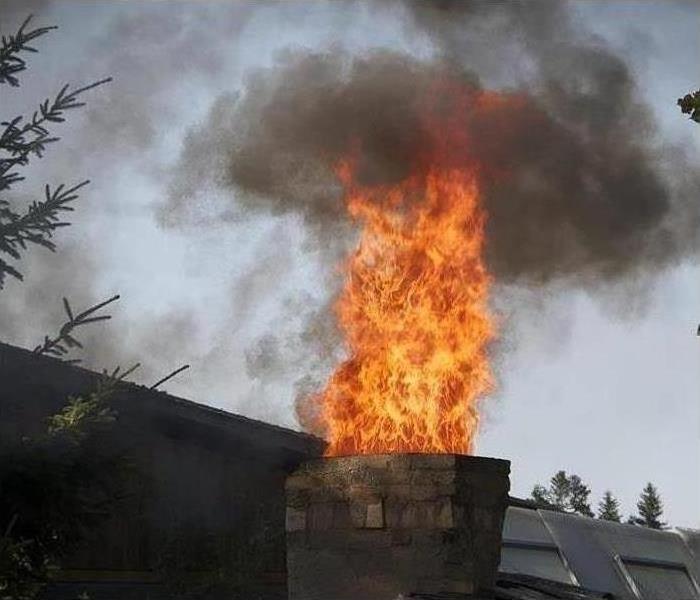 Chimney fires account for more than $120 million in damage every year.
Chimney fires account for more than $120 million in damage every year.
Did you know chimney fires account for over $120 million in damage every year? As you prepare for colder winter months, be sure to get your chimney cleaned.
If you do experience fire damage in your home, here are some Do and Don't tips:
DO:
- Limit movement in the home to prevent soot particles from being embedded into upholstery and carpets.
- Place clean towels or old linens on rugs, upholstery and carpet traffic areas until cleaning is complete.
- Blow or brush vacuum, loose soot particles from upholstery, drapes, and carpets.
- Wash house plants on both sides of leaves.
- Clean and protect chrome on kitchen and bathroom faucets, trim and appliances.
- Change HVAC filter.
- Tape double layers of cheesecloth over air registers to prevent redistribution of soot from ducts.
DON’T:
- Attempt to wash any walls or painted surfaces.
- Attempt to shampoo carpet or upholstery.
- Send garments to ordinary dry cleaner. Improper cleaning may set smoke odor.
Picture This
9/24/2018 (Permalink)
 In order to prevent further damage to your belongings, call SERVPRO of The Southtowns IMMEDIATELY after a fire.
In order to prevent further damage to your belongings, call SERVPRO of The Southtowns IMMEDIATELY after a fire.
Picture this; you have just entered your home after a fire. There is black soot EVERYWHERE making the house feel dark and cold. There is a horrible odor that has permeated the entire house. Your life is in chaos as you try to figure out where to go from here.
That’s when your instincts kick in. Every day you clean your kitchen table, its routine, which is now covered in black soot. You rush to underneath your sink and pull out your trusty bottle of cleaner, and begin to clean your kitchen table because it is all you know what to do at this moment.
This is the WORST thing you could possible do! There are different types of soot, each requiring its own special cleaning process. Should you experience a fire this year, please call the professionals at SERVPRO of The Southtowns IMMEDIATELY to begin the fire restoration process.
While you wait for help you can:
- Limit movement in the home to prevent soot particles from being embedded into upholstery and carpets.
- Keep hands clean. Soot on hands can further spoil upholstery, walls, and woodwork.
- Place old towels or old linens on rugs, upholstery, drapes, and carpets.
Fire damage can be devastating. Let the professionals at SERVPRO of The Southtowns make it “Like It Never Even Happened”.
When Fire Disaster Strikes: Why You Should Never Clean Up After A Fire
6/19/2018 (Permalink)
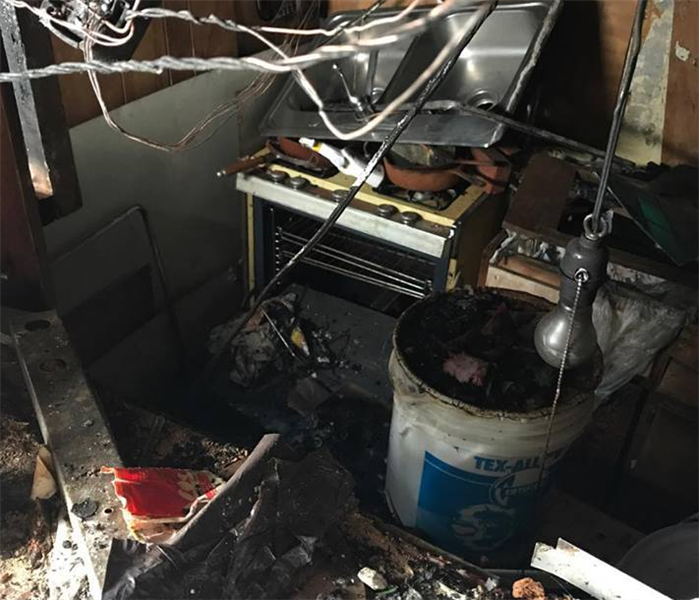 There are different types of smoke, each requiring a different cleaning method.
There are different types of smoke, each requiring a different cleaning method.
After experiencing a fire it may be tempting to start the clean-up yourself immediately. However, this is one of the biggest mistakes a homeowner can make. There are two types of smoke, wet and dry, and each type may greatly affect the restoration process.
Wet smoke is caused from plastic and rubber burning. It smolders at a low heat, has a very pungent odor, and is often sticky and smeary. With wet smoke, smoke webs are more difficult to clean.
Dry smoke is caused from paper and wood. The fire is fast burning and burns at a high temperature. Heat rises, therefore the smoke rises as well leaving soot on everything in its path.
Protein fire residue, which is produced by evaporation of material rather than from a fire, may also be present after a fire. This residue is virtually invisible and discolors paint and varnishes. Like wet smoke, it also has an extreme pungent odor.
SERVPRO of The Southtowns will test the soot to determine which type of smoke damaged occurred, and then develop a comprehensive plan of action to restore your home. Since each smoke and fire damage situation is a little different, each one requires a unique solution tailored for the specific conditions. We have the equipment, expertise, and experience to restore your fire and smoke damage. We will also treat your family with empathy and respect and your property with care.
Did You Know Soot Damaged Documents Can Be Restored?
4/11/2018 (Permalink)
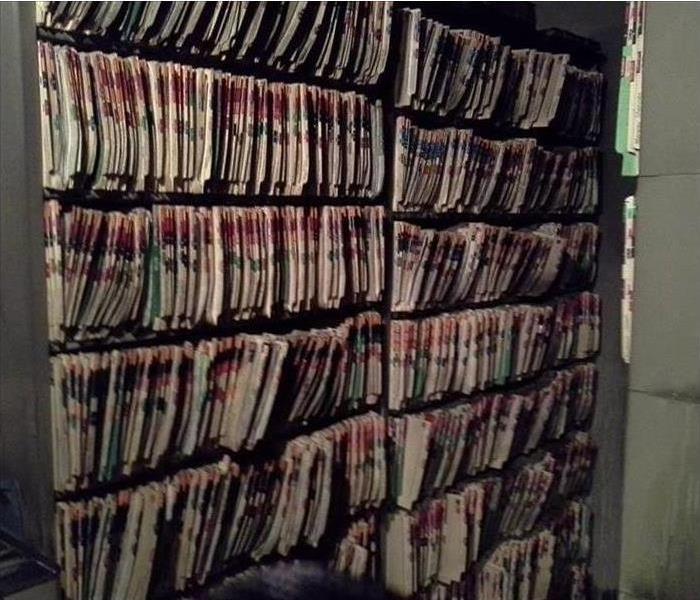 Even soot damaged documents can be restored!
Even soot damaged documents can be restored!
The file room is one place where you never want to have fire or water damage, but when distaster strikes SERVPRO of The Southtowns can restore important documents to a usable condition to keep your business running smoothly.
These are medial documents at a doctors office where a small fire caused a great deal of soot damage. We are HEPA compliant and were able to deodorize and restore these documents while keeping the files in compliance.
As experts in deodorization, SERVPRO of The Southtowns is trained to identify and eliminate offensive odors. These odors can come from a number of sources both inside and outside a structure.
SERVPRO teaches IICRC technical classes in the proper removal of odors. Masking and other short cuts don't work when your odor problem is serious or persistent.
We have the training and equipment to identify and eliminate these offensive odors. By identifying the cause of the odor and determining the conditions in which it contact any surfaces, the odor can often be removed over time without a trace. Our technicians have access to several odor removal products capable of penetrating surfaces to neutralize an unpleasant odor thoroughly.
The science of identifying and eliminating odors can be a tricky thing, so give us a call, and leave the restoration to us.
Debunking a Major Misconception
3/9/2018 (Permalink)
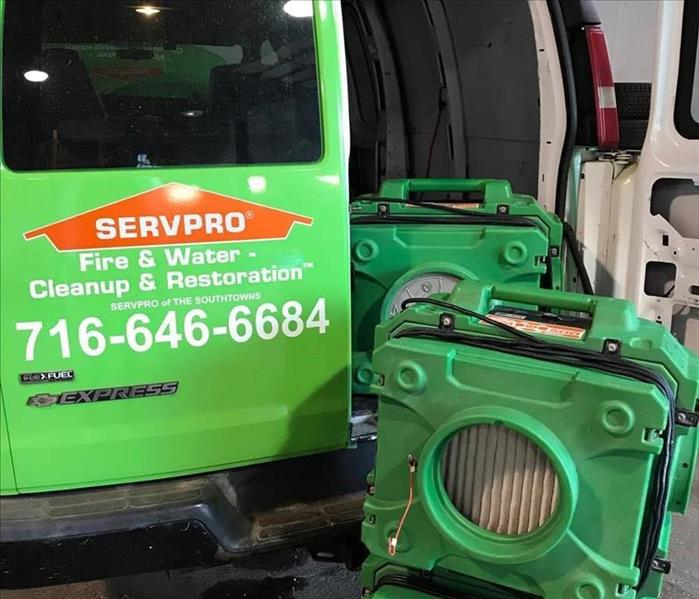 Having a professional on scene to assess the damage quickly can be the difference between hundreds of dollars vs. thousands of dollars
Having a professional on scene to assess the damage quickly can be the difference between hundreds of dollars vs. thousands of dollars
A general misconception among people that have suffered fire and/or water damage is that, "It is less expensive to replace rather than to restore." However, professional technicians at SERVPRO of The Southtowns are trained to see beyond the misconceptions.
The mitigation process of cleaning yields excellent results at a cost-effective price. Mitigation stops further damage and reduces the loss, while restoration puts the damaged items back to their preloss condition. For ultimate results, mitigation needs to begin within twenty-four hours of a loss. Any delay will complicate or, may devalue the mitigation effort. In order to guarantee the removal of smoke odor, all of the contaminated areas need to be cleaned, deodorized and possibly sealed (where applicable). Also, all odor molecules, whether airborne or absorbed, need to be neutralized.
Our SERVPRO professionals utilize testing and measuring equipment to ensure that the moisture content has been returned to normal standards. Thus, preventing a multi-thousand dollar mold claim in the future, caused by ineffective drying. State-of-the-art meters and sensors allow us to document and record data that justifies equipment usage, as well as allow us to know when to safely remove it.
Only the professionals at SERVPRO of The Southtowns can make it "Like it never even happened."
Space Heater Safety Tips
11/30/2017 (Permalink)
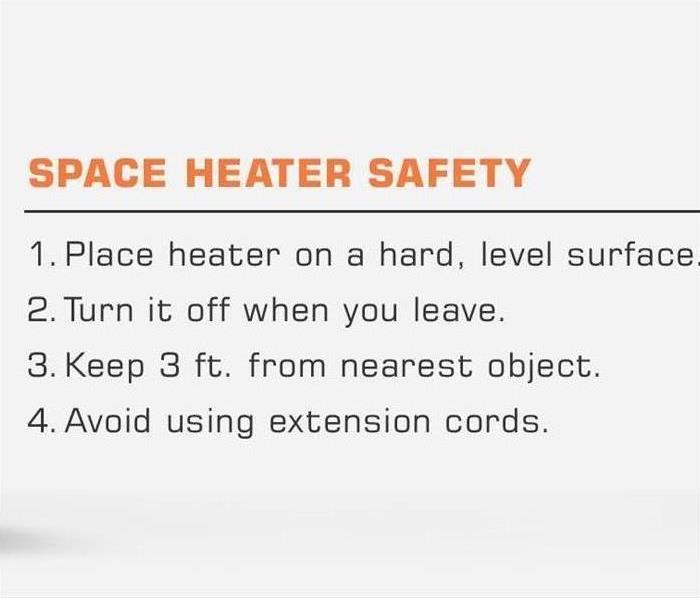 Space Heater Safety Tips
Space Heater Safety Tips
It is going to be cold in WNY for the next week, here are some great space heater safety tips to prevent fires.
Electric space heaters are generally more expensive to operate than combustion space heaters, but they are the only unvented space heaters that are safe to operate inside your home. Although electric space heaters avoid indoor air quality concerns, they still pose burn and fire hazards and should be used with caution.
1. Place heater on a hard, level surface
2. Turn heater off when you leave
3. Keep heater 3 ft. from the nearest object
4. Avoid using extension cords
5. Look for heaters with tip over and over heat protection
6. Keep heaters away from water and flammable items such as papers, blankets, and curtains.
Educating yourself about the safety hazards that come with the improper use of portable heaters will help you achieve better peace of mind as you keep your home warm, comfortable, and fire hazard-free this winter.
Chimney Fires Cause Over $120 Million in Damage
11/29/2017 (Permalink)
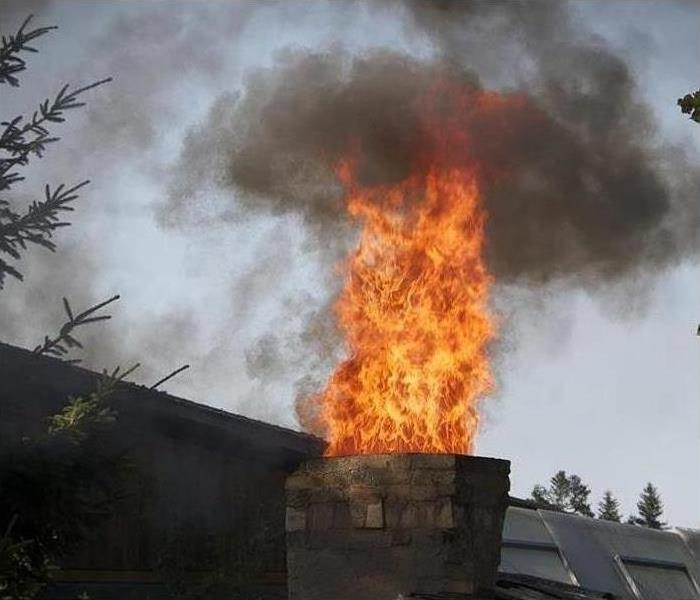 Chimney fires account for over $120 million in damage every year.
Chimney fires account for over $120 million in damage every year.
Did you know chimney fires account for over $120 million in damage every year? As you prepare for colder winter months, be sure to get your chimney cleaned.
If you do experience fire damage in your home, here are some Do and Don't tips:
DO:
- Limit movement in the home to prevent soot particles from being embedded into upholstery and carpets.
- Place clean towels or old linens on rugs, upholstery and carpet traffic areas until cleaning is complete.
- Blow or brush vacuum, loose soot particles from upholstery, drapes, and carpets.
- Wash house plants on both sides of leaves.
- Clean and protect chrome on kitchen and bathroom faucets, trim and appliances.
- Change HVAC filter.
- Tape double layers of cheesecloth over air registers to prevent redistribution of soot from ducts.
DON’T:
- Attempt to wash any walls or painted surfaces.
- Attempt to shampoo carpet or upholstery.
- Send garments to ordinary dry cleaner. Improper cleaning may set smoke odor.
Choosing the Appropriate Fire Extinguisher
9/15/2017 (Permalink)
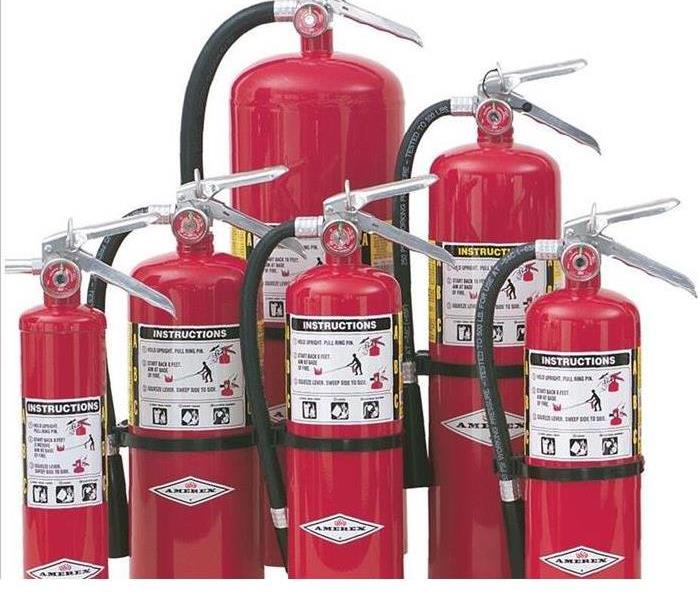 Know your fire extinguisher
Know your fire extinguisher
Know your fire extinguisher! Using the proper type of extinguisher saves lives.
Class A: This is the most common extinguisher and can e used to put out fires in ordinary combustibles such as cloth, wood, rubber, paper and many plastics.
Class B: Used on fires involving flammable liquids, such as grease, gasoline and oil.
Class C: Designed for fires involving appliances, tools, or other equipment electronically energized or plugged in.
Class D: For use on flammable metals: often specific for they type of metal in question. These are typically found only in factories working with these metals.
Class K: Intended for use on fires that involve vegetable oils, animal oils, or fats in cooking appliances. These extinguishers are generally found in commercial kitchens, but are becoming more popular in residential market for use in kitchens.
Fire Damage Tips
6/19/2017 (Permalink)
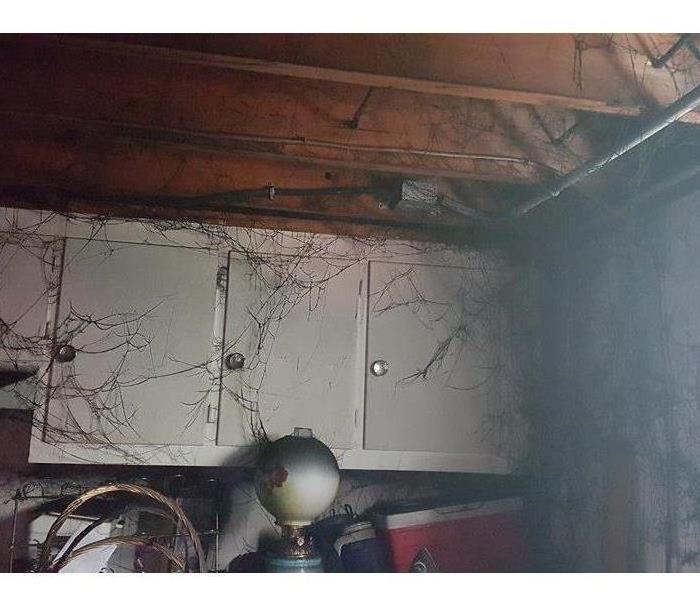 "Soot Webs" may form from very hot fires
"Soot Webs" may form from very hot fires
Have you ever experienced something like this? After a fire "soot webs" may form, this is a reaction of the heat and smoke, not the result of poor house keeping. Always call your SERVPRO of The Southowns professionals before attempting to clean fire damage yourself.
Fire and Smoke - Home Emergency Tips
DO:
- Limit movement in the home to prevent soot particles from being embedded into upholstery and carpets
- Keep hands clean. Soot on hands can further spoil upholstery, walls, and woodwork
- Blow or brush vacuum loose soot particles from upholstery, drapes, and carpets
- Place old towels or old linens on rugs, upholstery, and carpet traffic areas.
- If electricity is off, empty freezer and refrigerator completely and prop doors open
- Clean and protect chrome on kitchen and bathroom faucets, trim and appliances with a light coating of Vaseline or oil.
- Wash house plants on both sides of leaves
- Change HVAC filter
- Tape double layers of cheesecloth over air registers
DON’T:
- Attempt to wash any walls or painted surfaces without first contacting your SERVPRO Professional
- Attempt to shampoo carpet or upholstered furniture without first consulting your SERVPRO Professional
- Attempt to clean any electrical appliances, TV sets, radios, etc that may have been close to fire, heat or water without first consulting an authorized repair service
- Use any canned or packaged food or beverages that may have been stored close to fire, heat or water. (They may be contaminated.)
- Turn on ceiling fixtures if ceiling is wet. Wiring may be wet or damaged.
- Send garments to ordinary dry cleaner. Improper cleaning may set smoke odor.
Ultra Content Cleaner
3/3/2017 (Permalink)
 Ultra Content Cleaner is an environmentally friendly, bio-based detergent
Ultra Content Cleaner is an environmentally friendly, bio-based detergent
All of the products we use at SERVPRO are specially formulated, in house, to work based on 50 years of experience in the restoration industry.
Product Spot Light
Ultra Content Cleaner is an environmentally friendly, bio-based detergent designed to clean Fire Damaged Contents. It contains a proprietary blend of detergents and surfactants designed to be tough on soot and contains exclusive deodorizing components to help break down, neutralize and remove smoke odor particles while leaving a fresh lemon fragrance.
Trust the experts for 50 years in fire damage restoration. SERVPRO of The Southtowns is committed to the best products, the best people, and the best training so we can make fire damage "Like it never even happened."
24/7, 365 days a year, fire knows no rest, so neither do we.
Bethlehem Steel fire in Lackawanna, NY
11/14/2016 (Permalink)
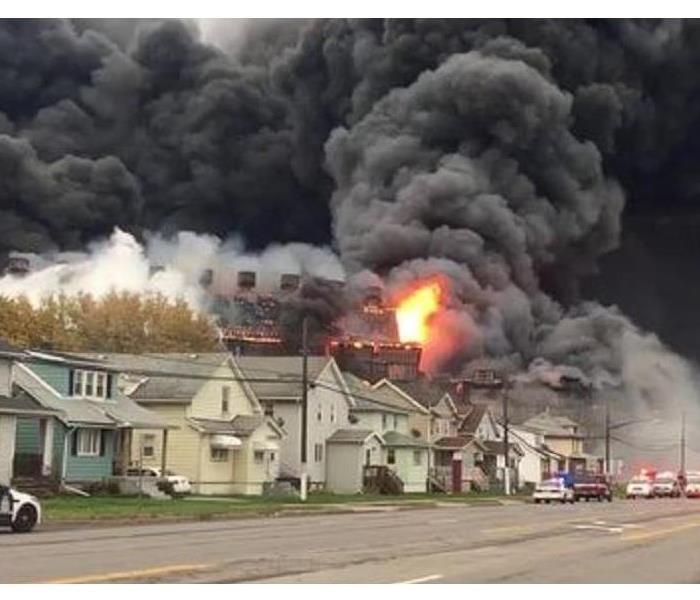 The fire at Bethlehem Steel blacked skies and distributed ash for many miles
The fire at Bethlehem Steel blacked skies and distributed ash for many miles
I am dashing you off a quick note to offer our hope that all of our friends in the Lackawanna, Blasdell, and South Buffalo areas stay safe from the ongoing Bethlehem Steel fire. The damage is far reaching as all the way here in Hamburg we are experiencing soot falling into our parking lots.
Please know that we are giving top priority to any customers who call us needing soot clean up and deodorization due to this event.
This can be a stressful situation for families as their lives and sense of safety is being invaded by a force outside of their control. We will work with the community closely to put all those effected at ease and get them back to normal as quickly as possible.
Fire damage restoration is our specialty and we have the experience to deal with any unique situations that arise. Please feel free to call me with any specific questions.
Buffalo Smoke and Soot Cleanup
9/6/2016 (Permalink)
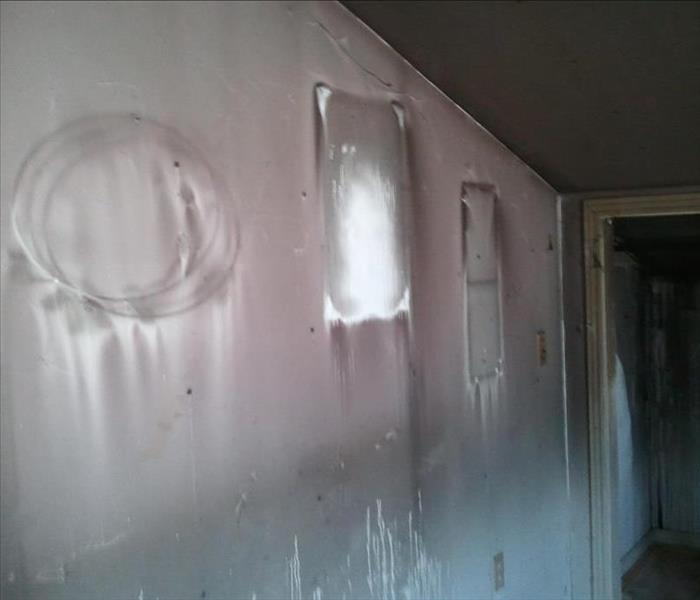 Smoke and Soot Damage Can Cause a Pervasive Odor in Your Buffalo Home.
Smoke and Soot Damage Can Cause a Pervasive Odor in Your Buffalo Home.
Smoke and soot is very invasive and can penetrate various cavities within your home, causing hidden damage and odor. Our smoke damage expertise and experience allows us to inspect and accurately assess the extent of the damage to develop a comprehensive plan of action.
Smoke and soot facts:
- Hot smoke migrates to cooler areas and upper levels of a structure.
- Smoke flows around plumbing systems, seeping through the holes used by pipes to go from floor to floor.
- The type of smoke may greatly affect the restoration process.
Different Types of Smoke
There are two different types of smoke–wet and dry. As a result, there are different types of soot residue after a fire. Before restoration begins, SERVPRO® of The Southtowns will test the soot to determine which type of smoke damage occurred. The cleaning procedures will then be based on the information identified during pretesting. Here is some additional information:
Wet Smoke – Plastic and Rubber
- Low heat, smoldering, pungent odor, sticky, smeary. Smoke webs are more difficult to clean.
Dry Smoke – Paper and Wood
- Fast burning, high temperatures, heat rises therefore smoke rises.
Protein Fire Residue – Produced by evaporation of material rather than from a fire
- Virtually invisible, discolors paints and varnishes, extreme pungent odor.
Our Fire Damage Restoration Services
Since each smoke and fire damage situation is a little different, each one requires a unique solution tailored for the specific conditions. We have the equipment, expertise, and experience to restore your fire and smoke damage. We will also treat your family with empathy and respect and your property with care.
Have Questions about Fire, Smoke, or Soot Damage?
Call Us Today – 716-646-6684
Winter Fires
2/26/2016 (Permalink)
Did you know over $2 billion in property loss occurs from winter fires? Will you be prepared if it happens to you?
Most home fires are preventable, but sometimes common sense isn't so common. According to the National Fire Protection Association, it's not too early to protect your loved ones and your home from fire damage, by simply following sensible suggestions.
1. Have your furnace checked.
2. Have your chimneys and vents checked.
3. Test smoke alarms. Make sure batteries are fresh. Place smoke alarms in the kitchen, laundry room and in bedrooms.
4. Cover the fireplace with a screen.
5. Beware of lit candles.
6. Beware of space heaters.
7. Know how to put out kitchen fires quickly. Water doesn't help a greasefire, which can get out of control. Keep salt and baking soda on hand to sprinkle liberally on pan fires. Keep lids handy to put on top of pots and pans that get too hot.
8. Practice an escape route. Businesses have fire drills, your family should, too.
9. Fire extinguishers can be life-savers. Store one under the kitchen sink, and in the hall closet near the bedrooms. Make sure you use the correct setting -- A for paper, wood and trash; B for grease and flammable liquids; C for small electrical fires.
10. All household members should know 911.
Space Heater Safety Tips
2/10/2016 (Permalink)
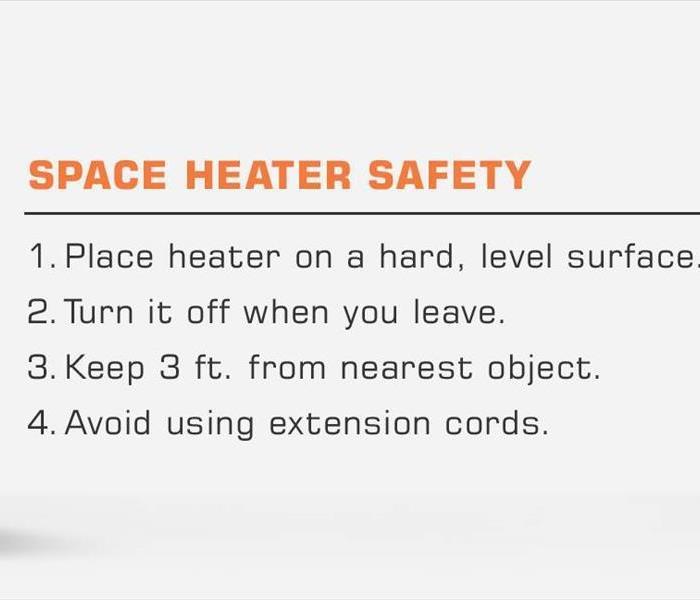 Space Heater Safety Tips
Space Heater Safety Tips
It is going to be cold in WNY for the next week, here are some great space heater safety tips to prevent fires.
Electric space heaters are generally more expensive to operate than combustion space heaters, but they are the only unvented space heaters that are safe to operate inside your home. Although electric space heaters avoid indoor air quality concerns, they still pose burn and fire hazards and should be used with caution.
1. Place heater on a hard, level surface
2. Turn heater off when you leave
3. Keep heater 3 ft. from the nearest object
4. Avoid using extension cords
5. Look for heaters with tip over and over heat protection
6. Keep heaters away from water and flammable items such as papers, blankets, and curtains.
Educating yourself about the safety hazards that come with the improper use of portable heaters will help you achieve better peace of mind as you keep your home warm, comfortable, and fire hazard-free this winter.
Fire Damage
1/25/2016 (Permalink)
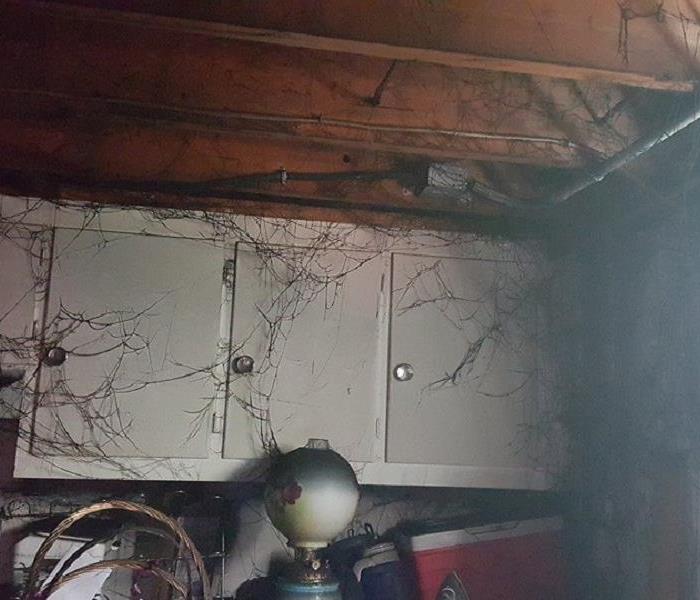 Soot Webs occur from very hot fires
Soot Webs occur from very hot fires
Have you ever experienced something like this? After a fire "soot webs" may form, this is a reaction of the heat and smoke, not the result of poor house keeping. Always call your SERVPRO of The Southowns professionals before attempting to clean fire damage yourself.
Fire and Smoke - Home Emergency Tips
DO:
- Limit movement in the home to prevent soot particles from being imbedded into upholstery and carpets
- Keep hands clean. Soot on hands can further spoil upholstery, walls, and woodwork
- Blow or brush vacuum loose soot particles from upholstery, drapes, and carpets
- Place old towels or old linens on rugs, upholstery, and carpet traffic areas.
- If electricity is off, empty freezer and refrigerator completely and prop doors open
- Clean and protect chrome on kitchen and bathroom faucets, trim and appliances with a light coating of Vaseline or oil.
- Wash house plants on both sides of leaves
- Change HVAC filter
- Tape double layers of cheesecloth over air registers
DON’T:
- Attempt to wash any walls or painted surfaces without first contacting your SERVPRO Professional
- Attempt to shampoo carpet or upholstered furniture without first consulting your SERVPRO Professional
- Attempt to clean any electrical appliances, TV sets, radios, etc that may have been close to fire, heat or water without first consulting an authorized repair service
- Use any canned or packaged food or beverages that may have been stored close to fire, heat or water. (They may be contaminated.)
- Turn on ceiling fixtures if ceiling is wet. Wiring may be wet or damaged.
- Send garments to ordinary dry cleaner. Improper cleaning may set smoke odor.
Throw Back to the 90's
1/19/2016 (Permalink)
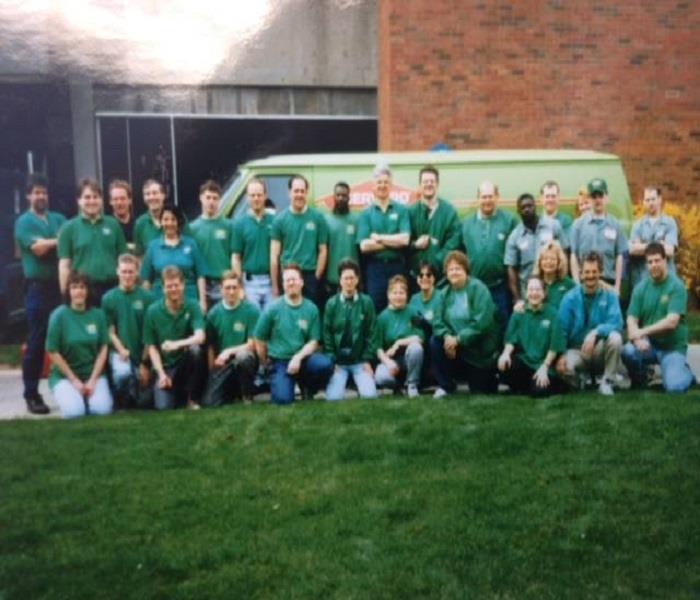 MCC Fire in science lab
MCC Fire in science lab
MCC Fire in science lab circa the mid 1990s. Do you see Lyn and Thom Braun?!
SERVPRO of The Southtowns has been performing fire and water restoration under the ownership to Thom and Lyn since 1995 and we continue to be dedicated to ongoing training.
All of our crew and staff have weekly training on equipment and procedures to keep knowledge fresh and up to date. In an ever changing industry we provide IICRC certification in Water Damage Restoration and Fire Restoration. Our crews are also NYS Mold Remediation certified and Lead abatement certified.
It is important for us that all of the SERVPRO of The Southtowns staff is well educated in not only fire and water restoration but also safety procedures to protect themselves and their team mates in what can include hazardous situations.






 24/7 Emergency Service
24/7 Emergency Service

























